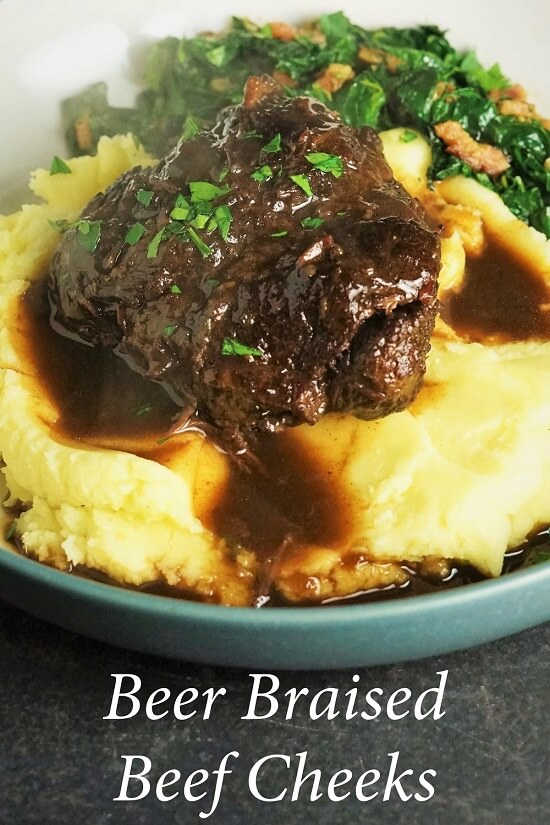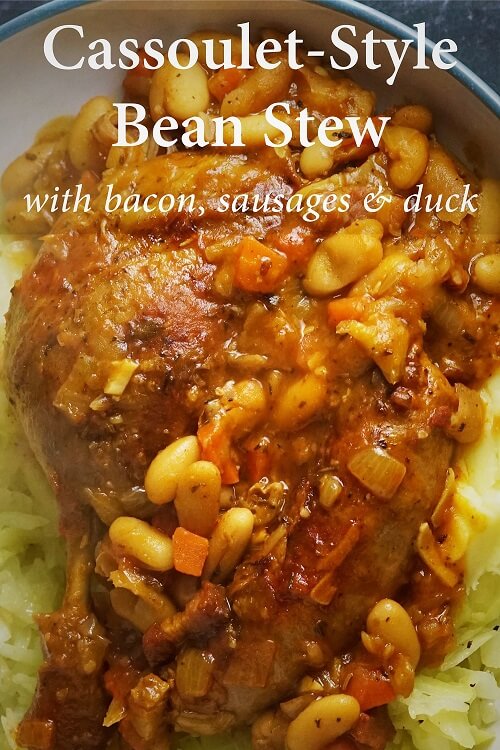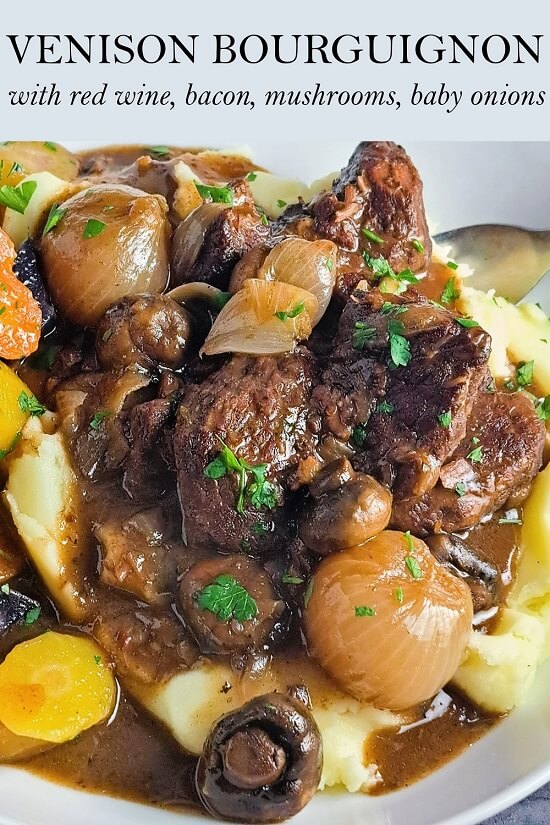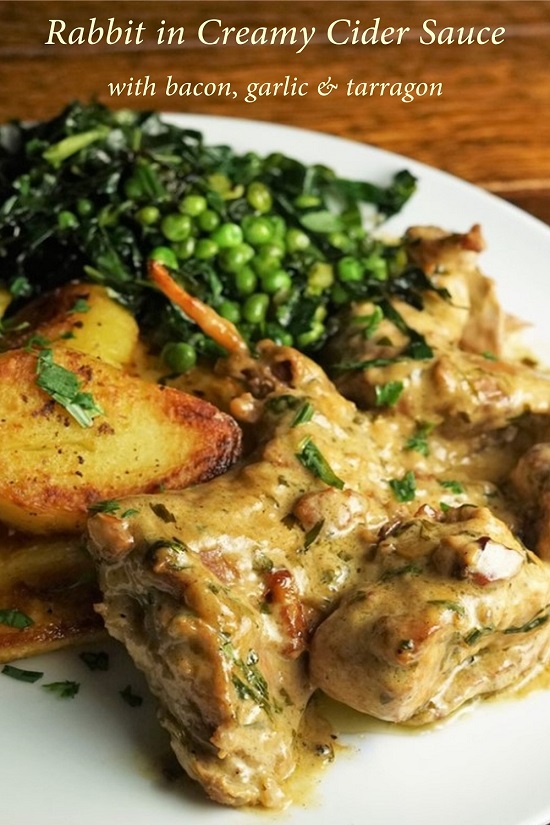Pork Braised in Cider with Apples
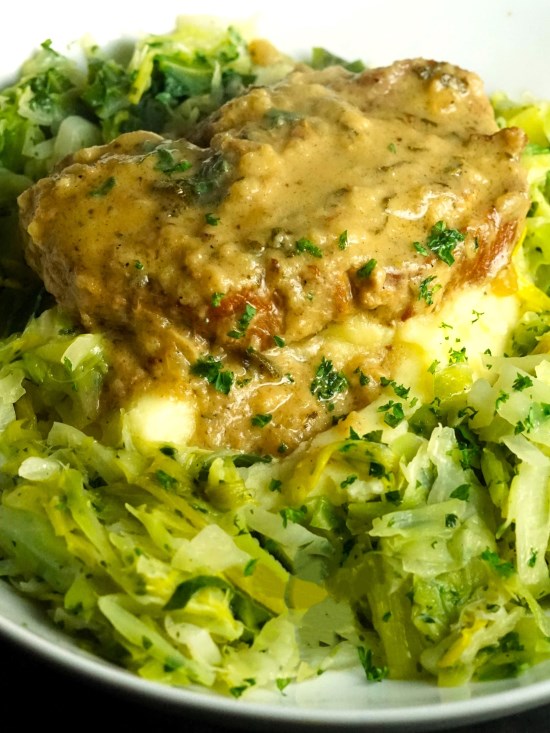
Pork Braised in Cider with Apples is a delicious, rich, comforting dish that’s perfect for the cooler months.
Pork rib eye steaks (or you can substitute pig cheeks) become beautifully tender cooked in cider and chicken stock. Along with onions, garlic and sage, apples add their tangy flavour to the rich sauce. Slow cooked in the oven, or speeded up in the Instant Pot pressure cooker, an optional dash of double cream adds a touch more luxury.
So good served over mashed potatoes or rice with a side of green veggies.
Jump to Recipe
Well into Autumn now, I’m increasingly craving rich, meaty stews and braises for dinner. As the evenings get chillier, there’s something so comforting about tasty, tender meat served with the delicious sauce it was cooked in. Hearty food like Beer Braised Beef Cheeks or Cassoulet with duck legs, sausages, and beans is exactly what I want this time of year.
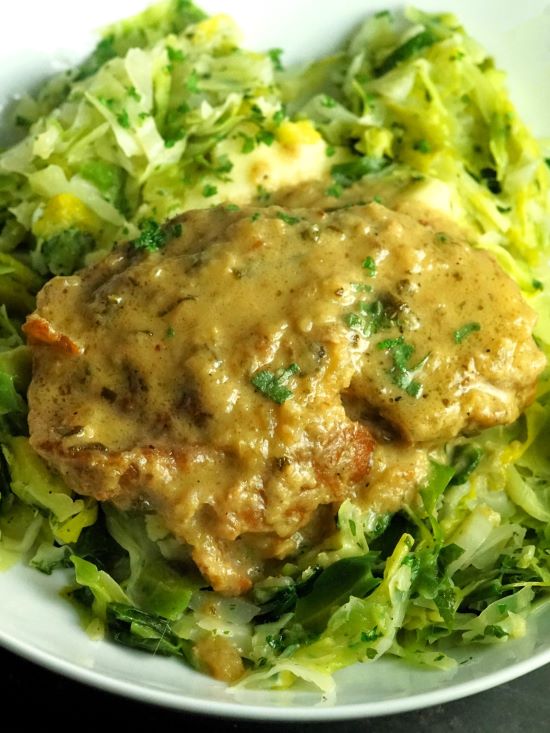
The recipe I’m sharing today is another favourite and fits the bill perfectly. Soft-as-anything pork in a substantial sauce that’s aromatic with onions, garlic and sage, plus the tang of cider and apples. I love to finish it with a little double cream too.
WHICH PORK CUT TO USE?
For the meat, I’ve used pork rib eye steaks. I admit they’re perhaps not something you can easily find in a supermarket. But a good butcher should be able to get them for you. Just like the more familiar beef rib eye, you can eat them like a steak. But, well marbled with fat, pork rib eye is also great for braising. This recipe serves four, so I’ve used four pork rib eyes which in total weighed roughly 800 grams.
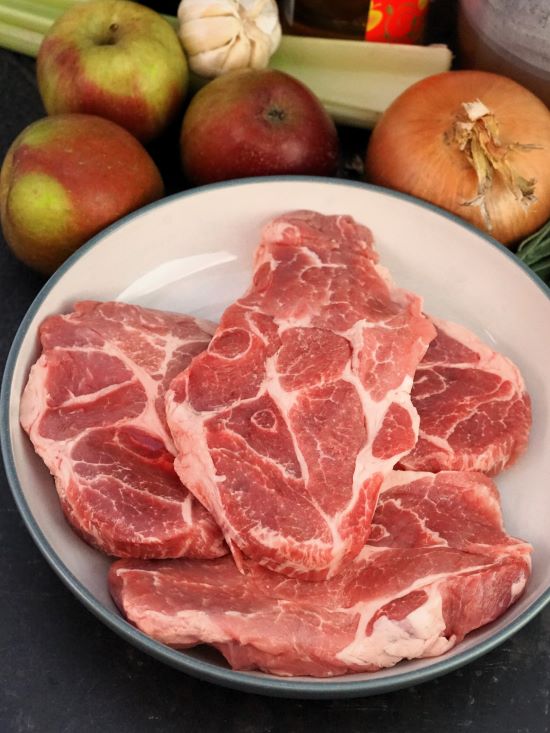
Braising meat simply means to brown and seal in fat then slowly simmer in liquid until tender. For my pork rib eye steaks, I use a combination of cider and chicken stock. Cooked this way, the fat melts into the sauce while the meat becomes incredibly tender.
In this post I’ve used good quality pork from Packington Free Range here in Staffordshire. I buy it from excellent local supplier Dunwood Farm Butchery who also deliver nationwide across the UK.
If you can’t get pork rib eye, you could substitute the same weight of pig cheeks. Failing that, you could try it with diced pork shoulder and reduce the cooking time accordingly.
PORK BRAISED IN CIDER WITH APPLES
You’ll find a detailed recipe card at the end. But I recommend you read the rest of this post first for tips and step-by-step images.
In the recipe card I’ve included instructions for making this dish in the oven AND in the Instant Pot electric pressure cooker. Although this blog post focusses mainly on making it in the oven, the steps are essentially the same.
If you’re braising in the oven then you’ll need a roomy, lidded casserole dish that can also go on top of the stove.

INGREDIENTS
Besides the pork plus salt and pepper, the other ingredients you’ll need are:
- Oil or fat e.g. olive oil, lard, or fat saved from roasting meat. This is used to brown the pork and soften the vegetables.
- Onion, garlic, celery. These form the base of the sauce. A whole head of garlic may seem a lot but is very mild by the end of cooking.
- Apples. Use 3 dessert apples, skinned. Cooking apples aren’t recommended unless you’re happy with them completely breaking down in the sauce.
- Sage. A classic accompaniment with pork, fresh is best for this recipe. If you only have dried, use 2 – 3 heaped teaspoons.
- Cider. I think a medium cider is best, but use dry if you prefer. Avoid sweet cider as it will be too sweet.
- Cider vinegar. Adds an extra tang to the sauce.
- Stock. Chicken stock is recommended but you could swap in vegetable if that’s what you have.
- Double cream. Just a few tablespoons is enough to make the sauce extra rich. You could leave out though, or replace with crème fraiche.
METHOD
If you’ve made any sort of casserole or braise before, then the basic technique for making Pork Braised in Cider with Apples will be familiar.
We start by seasoning the meat with salt and pepper then browning it in hot fat. To get good colour you shouldn’t crowd the pot, so brown in batches if necessary. Instant Pot users should use the Sauté button. Transfer all the pork to a plate when browned, and put in the prepared onion, celery, and garlic. Stir around over medium heat for ten minutes or so or until they’re softening.
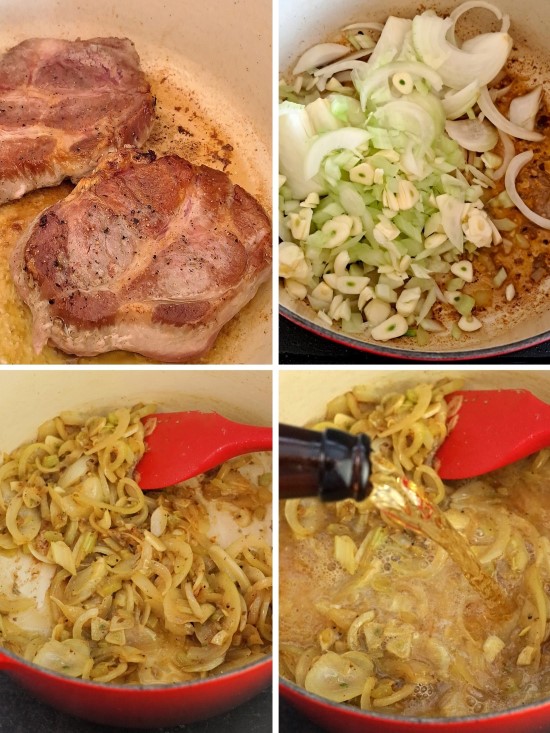
Next, the cider and vinegar go in. With a spoon, scrape up all the browned bits from the bottom of the pot and let everything bubble over high heat. What we’re aiming for is the liquid to reduce by about two thirds.
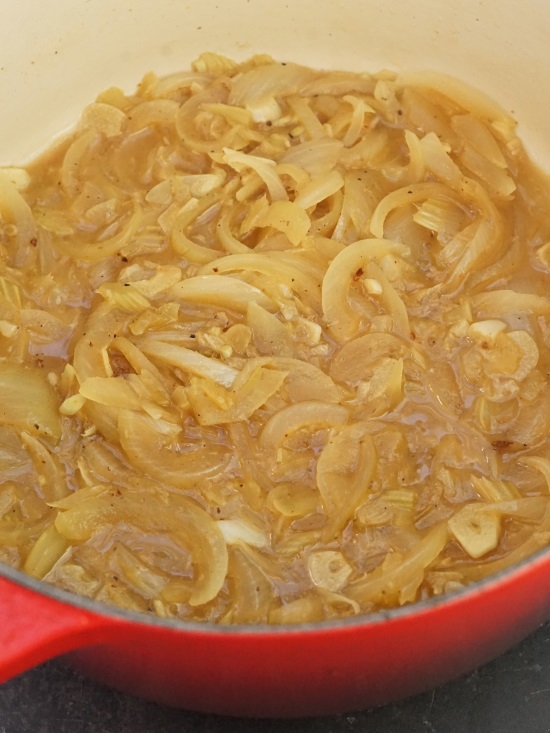
While that’s happening, you can peel and chop your apples. I don’t do it earlier as they may go unpleasantly brown. On the other hand, you probably wouldn’t notice it in the finished dish anyway.
Now we can put the pork back in the pot along with the chopped apples. If you’re using fresh sage, put in half of it, shredded or chopped. For dried sage, add it all now. We also pour in the stock. You only need enough to almost cover the meat – bear in mind it’s going to shrink a little and the veg even more so. Depending on the dimensions of your pot, shape, and size of the pork etc., around 400 ml should do it. Now bring the whole lot up to a boil.
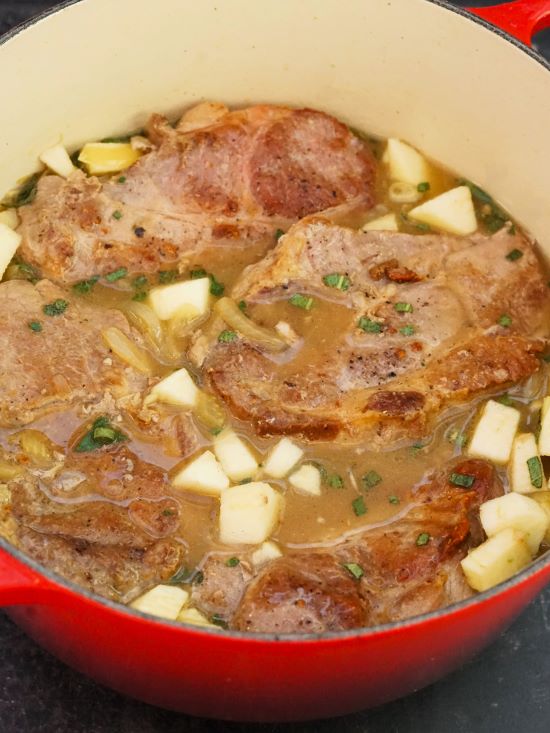
If you’re going to braise in the oven, you’ll have preheated it to 150° C / 130° Fan / Gas 2 / 300 F right at the start. Put a lid on the casserole and pop it in. Pork rib eye should take 1.5 – 2 hours to get very tender. Instant Pot users should ensure the lever is set to Sealing, press Manual, then use the + / – buttons to set the time to 40 minutes. If you’ve used pork other than rib eye, remember to adjust times accordingly. For example, pig cheeks are likely to take longer, while diced shoulder will cook more quickly.
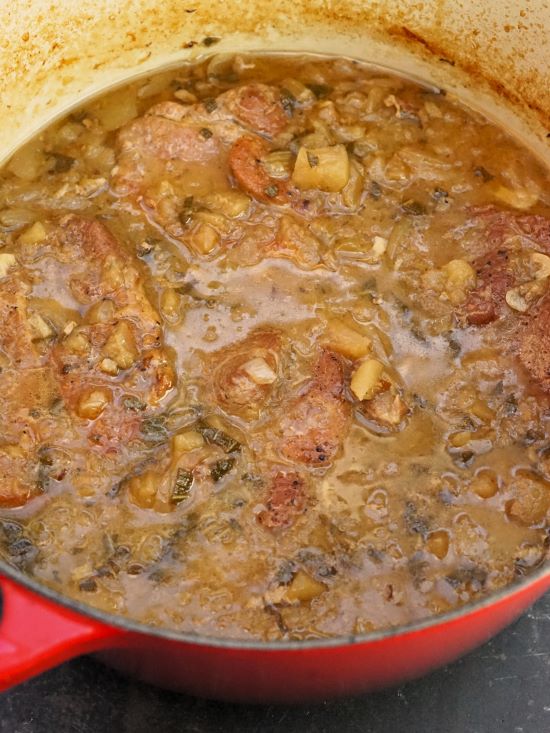
FINISHING THE SAUCE
While the meat was cooking, all the flavours of the sauce will have been developing beautifully. But I have a few tricks to get it even better!
Start by carefully removing the meat with tongs, slotted spoon or similar. Set it aside for now. Then go through the following steps:
- Naturally thicken the sauce by whizzing with a stick blender. Don’t make it completely smooth, just blend about a third of it.
- If the sauce still seems a little thin (more likely if you’ve used an Instant Pot as there’s next to no evaporation during cooking) bubble it on top of the stove or use the Instant Pot Sauté button.
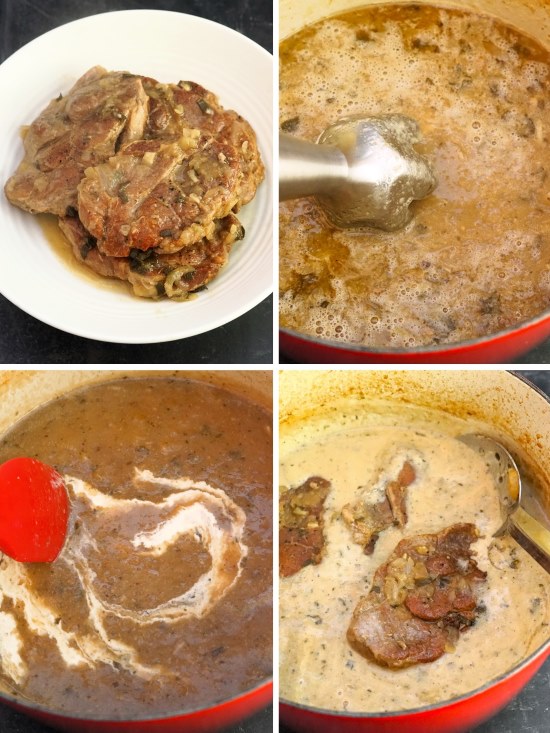
- Stir in 3 – 4 tablespoons of double cream plus any remaining fresh sage, and bubble for a few more minutes.
- Finally, put the cooked pork into the sauce and very gently simmer for about 5 minutes.
SERVING PORK BRAISED IN CIDER WITH APPLES
Follow my easy steps, and what you should end up with is tender pork that you could literally eat with a spoon (I’ve done this with leftovers served over rice – see pic at the end). Along with that great meat, you’ll have a rich sauce that’s deeply savoury, lightly creamy, but with the tang of apples.
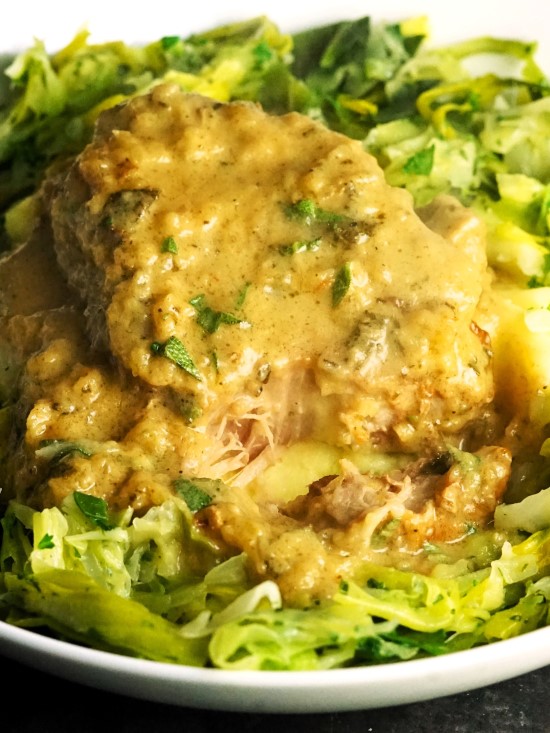
I love to serve Pork Braised in Cider with Apples over buttery mashed potatoes. I put a mound of potato in each bowl, flatten the top a little, place a pork steak on top, then spoon over a generous amount of that knockout sauce. As a counterpoint, quickly cooked fresh green vegetables are good alongside. Here I parboiled some cabbage and leeks then, just before serving, sauteed them in a little butter then stirred through some chopped parsley.
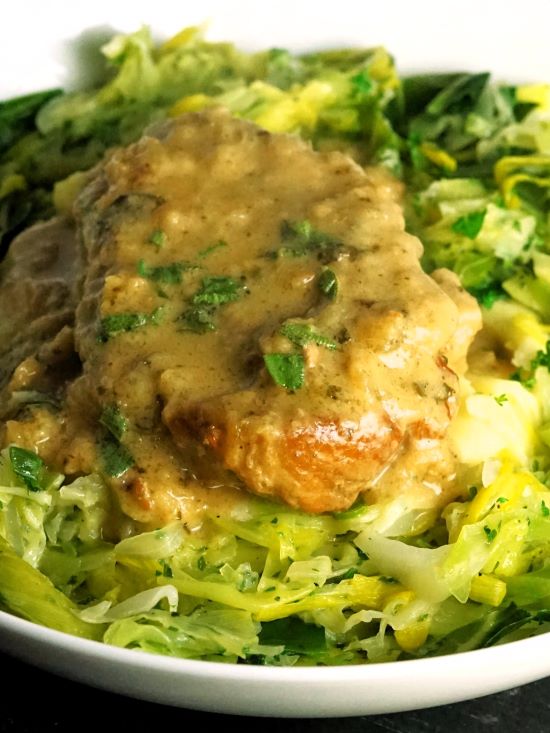
Even if, like mine, yours is a household of one or two people I highly recommend you make the full recipe and freeze some. It doesn’t take any longer to cook and I love knowing there’s a few portions of this great comfort food tucked away. When reheating, do it gently on top of the stove or in a low oven so the meat doesn’t breakdown or the sauce split. But it will taste good anyway!
I quite like the way the sauce reduces and becomes more concentrated on heating up. But you can always thin with extra stock if preferred.

If you’ve made this recipe, I’d love to hear from you. Please leave a comment.

Pork Braised in Cider with Apples
Pork rib eye, (or pig cheeks) so tender you can eat with a spoon, in a rich cider sauce with sage, garlic, tangy apple, and a touch of cream.
Serve over mashed potatoes or rice with a side of greens for perfect cold weather comfort food.
Includes instructions for braising in the oven or cooking in an Instant Pot electric pressure cooker.
Note: if you only have dried sage, use 2 - 3 tsp and add it all at step 6.
Ingredients
- 2 tbsp oil or fat e.g. olive oil, lard
- 800 g pork rib eye steaks (approximately 4) or same weight of pig cheeks
- salt and black pepper
- 1 large onion skinned, halved, sliced (not too thinly)
- 1 head garlic skinned, cloves thinly sliced
- 2 stalks celery finely chopped or sliced
- 3 medium dessert apples
- 1 small bunch sage (leaves only) shredded or chopped
- 300 ml medium dry cider
- 1 tbsp cider vinegar
- 400 - 500 ml chicken stock
- 3 - 4 tbsp double cream
Instructions
-
If you are going to braise the pork in the oven rather than cook in an Instant Pot [IP] preheat the oven to 150° C / 130° Fan / Gas 2 / 300 F.
-
Put the oil or fat in a large casserole dish over high heat or in the IP inner and press Sauté.
While it heats, lightly season the pork with salt and pepper.
-
When the oil or fat is hot brown the pork on all sides: don't crowd the pot and do it in batches if necessary.
Transfer the meat to a plate when well browned.
-
Reduce the heat to medium (on the IP, you'll need to press Cancel to let the temperature drop, then press Sauté again) then add the prepared onion, garlic, and celery.
Season with a little salt and good grind of pepper then cook, stirring often, until softening (approx. 10 min). Be sure to scrape up any browned bits from the bottom of the pot. If it looks dry, add a little more oil or fat.
-
Increase the heat under the casserole to high (or ensure the IP is hot) and pour in the cider and cider vinegar, stirring to scrape the bottom of the pot again.
Allow to bubble until reduced to about a third (approx. 5 - 8 min).
Meanwhile, peel the apples and cut into rough chunks.
-
Put the browned pork back into the pot, along with the chopped apples, and HALF the fresh sage.
Add enough stock to almost cover (approx. 400 ml), then push the meat underneath the liquid.
Bring up to a boil.
-
If using an IP
Press the Keep Warm/Cancel button, lock on the IP lid and make sure the lever is pointing to Sealing. Press the Manual button then use the + / - buttons to set the time to 40 minutes.
Leave until the time has elapsed and the indicator has counted down to zero. Switch off and leave until the pressure has naturally released. Switch the lever to Venting then carefully remove the lid. With two forks, test the pork: if it isn't completely tender then cook for a further 5 minutes and check again.
If cooking in the oven
Bring to a boil on top of the stove, then put in the preheated oven with a tight fitting lid. Cook until the pork is very tender (1.5 - 2 hours for rib eye, possibly longer for pig cheeks). Tip: at 45 min stir then push the meat under the liquid. If at any point too much liquid has evaporated, add a little more of the stock.
-
Remove the cooked pork from the pot and set aside.
To thicken the sauce (optional) use a stick blender to partly puree it without making it completely smooth.
If the sauce seems too thin (more likely if you've used the IP) then bubble on top of the stove or use the Sauté button until it's your desired consistency.
-
Stir in the double cream and the remaining sage and bubble to reduce a little.
Taste, and add more salt or pepper if needed.
Return the pork to the pot and gently simmer for 5 minutes before serving.
-
Can be stored in the fridge for 2 days or frozen. Reheat gently (after defrosting in the fridge overnight if necessary) on top of the stove or low oven.
RELATED RECIPES

